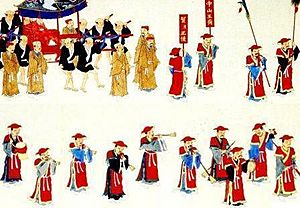Okinawa Islands facts for kids
|
Native name:
Okinawa Shotō (沖縄諸島)
|
|
|---|---|

Okinawa Islands
|
|
| Lua error in Module:Location_map at line 420: attempt to index field 'wikibase' (a nil value).
Okinawa Islands in Japan
|
|
| Geography | |
| Location | Pacific Ocean |
| Archipelago | Ryukyu Islands |
| Adjacent bodies of water | East China Sea |
| Total islands | 113 |
| Major islands | Okinawa Island, Kume Island, Kerama Islands |
| Area | 1,418.59 km2 (547.72 sq mi) |
| Administration | |
| Prefecture | Okinawa Prefecture |
| Largest settlement | Naha (pop. 312,393) |
| Demographics | |
| Population | 1,285,003 (October 1, 2010) |
| Pop. density | 908.8 /km2 (2,353.8 /sq mi) |
| Ethnic groups | Ryukyuan, Japanese |
The Okinawa Islands (沖縄諸島, Okinawa Shotō) are a group of islands in Okinawa Prefecture, Japan. They are the main island group of this prefecture. These islands are part of the larger Ryukyu Islands group. They are located between the Amami Islands to the northeast and the Sakishima Islands to the southwest.
Besides the main island, Okinawa, there are three smaller island groups. These are the Kerama, Yokatsu, and Iheya-Izena island groups.
The Okinawa Islands are very important for Okinawa Prefecture. They are the center for politics, culture, and population. The capital city of the prefecture, Naha, is located here. About 90% of the people in Okinawa Prefecture live on these islands. Most of them live on the largest island, Okinawa Island.
You can travel to the different Okinawa Islands mainly by small airplanes. These planes connect to Naha Airport. You can also use ferry services from the Port of Naha.
The Okinawa Islands have a subtropical climate. This means it's warm and humid, which is great for growing things. Farmers here grow sugarcane, pineapples, and beautiful cut flowers. You can also find United States military bases on the Okinawa Islands.
Long ago, the Ryukyu Kingdom ruled these islands. Its center was on Okinawa Island. This kingdom grew and spread its rule to the Miyako and Yaeyama Islands in the south and Amami Ōshima in the north.
Contents
A Look at Okinawa's History

Okinawa is now part of Japan. But it has its own special history and culture. This history is different from the rest of Japan. We can divide Okinawa's history into five main periods:
- Prehistoric era (Tens of thousands of years ago to the 12th century)
- Old Ryukyu era (12th century to 1609)
- Early modern Ryukyu era (1609 to 1879)
- Modern Okinawa era (1879 to 1945)
- Post-war era (1945 to today)
Early Times and the Ryukyu Kingdom
In the prehistoric era, people hunted animals and gathered plants for food. Around the 10th to 12th centuries, they started farming more. Many small villages formed. These villages then joined together into three small countries: Hokuzan, Chūzan, and Nanzan.
In 1372, Chūzan started sending gifts, called tribute, to the Chinese Ming Dynasty. This helped Chūzan become strong through trade with China. It then attacked the other countries. This led to the creation of the "Ryukyu Kingdom". This kingdom became very rich from trade all over Asia in the 15th and 16th centuries.
Changes Under Japanese Influence
In 1609, Shimazu Iehisa invaded the Ryukyu Kingdom. He was a powerful feudal lord from Satsuma Province in Japan. After this invasion, the Ryukyu Kingdom had to pay tribute to the Japanese shogunate (military government). This Japanese influence lasted until the late 1800s.
In 1867, the Japanese shogunate ended. Power went back to the Emperor Meiji. The new Japanese government wanted to make the Ryukyu Kingdom part of the Japanese Empire. In 1872, the Ryukyu Kingdom was renamed Ryukyu Domain. This meant Japan controlled it directly. In 1879, it became Okinawa Prefecture. This was the end of the Ryukyu Kingdom.
Okinawa's Modern Era
At first, Japan highlighted the differences between Okinawan and Japanese culture. Later, to show the world that Okinawa was truly part of Japan, policies changed. They focused on making Okinawan culture more like Japanese culture. For example, Okinawan children were taught that the Okinawan language was just a "dialect" of Japanese. Students were sometimes punished for speaking their native language.
Okinawa became involved in Japan's wars, including World War II. At the end of World War II, Okinawa became a major battlefield. Many people died, and the island's buildings and roads were completely destroyed.
Post-War Period and Today
After the war, the United States military took control of Okinawa. People hoped for more freedom. However, the U.S. military's needs were often put first. This led to a strong movement for Okinawa to return to Japan. This happened in 1972.
Even today, many U.S. military bases are still on Okinawa. The Japanese government often prioritizes U.S. military policies. This continues to be an important issue for the people of Okinawa.
Islands of Okinawa
The Japan Coast Guard defines the Okinawa Guntō. This group includes the following islands:
- Okinawa Island (Okinawa Hontō)
- Iheya-Izena Islands: Iheya Island, Izena Island
- Ie Island
- Sesoko Island
- Yokatsu Islands: Yabuchi Island, Henza Island, Miyagi Island, Ikei Island, Hamahiga Island, Tsuken Island, Ukibara Island, Minamiukibara Island, Kudaka Island
- Kume Island
- Kerama Islands: Tokashiki Island, Zamami Island, Aka Island, Geruma Island
- Aguni Islands: Aguni Island, Tonaki Island
The Geospatial Information Authority of Japan (GSI) also defines the Okinawa Shotō. This group is based on how islands are managed. It includes Iōtorishima, which is usually considered part of the Amami Islands.
See also
 In Spanish: Islas Okinawa para niños
In Spanish: Islas Okinawa para niños



